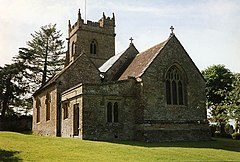Sutton Montis
| South Cadbury | |
|---|---|
 South Cadbury church |
|
| South Cadbury shown within Somerset | |
| Population | 284 (2011) |
| OS grid reference | ST632256 |
| District | |
| Shire county | |
| Region | |
| Country | England |
| Sovereign state | United Kingdom |
| Post town | YEOVIL |
| Postcode district | BA22 7 |
| Dialling code | 01963 |
| Police | Avon and Somerset |
| Fire | Devon and Somerset |
| Ambulance | South Western |
| EU Parliament | South West England |
| UK Parliament | |
South Cadbury is a village and civil parish in the South Somerset council area of the English county of Somerset. The parish includes the village of Sutton Montis.
It is famous as the location of the hill fort of Cadbury Castle, thought by some to be King Arthur's Camelot.
The name Cadbury means Cada's fort and refers to Cadbury Castle, which is immediately to the south west of the village. It is a vast Iron Age hill fort covering an area of around 20 acres (8 ha). The site has seen human occupation from Neolithic times until the late Saxon period. It was famously partially excavated by Leslie Alcock in the 1960s, when, amongst other things, an Arthurian period feasting hall was discovered. Since John Leland made reference to local traditions of a connection with King Arthur in the 16th century, there has been widespread speculation that this was the location of Camelot. King Arthur's Well sits at the foot of the hill and the local public house, the Red Lion, was renamed The Camelot when it was remodelled in 2004.
In the Domesday Book of 1086 the manor is recorded as held by Turstin FitzRolf.
The parish was part of the hundred of Catsash.
The parish council has responsibility for local issues, including setting an annual precept (local rate) to cover the council’s operating costs and producing annual accounts for public scrutiny. The parish council evaluates local planning applications and works with the local police, district council officers, and neighbourhood watch groups on matters of crime, security, and traffic. The parish council's role also includes initiating projects for the maintenance and repair of parish facilities, as well as consulting with the district council on the maintenance, repair, and improvement of highways, drainage, footpaths, public transport, and street cleaning. Conservation matters (including trees and listed buildings) and environmental issues are also the responsibility of the council.
...
Wikipedia

